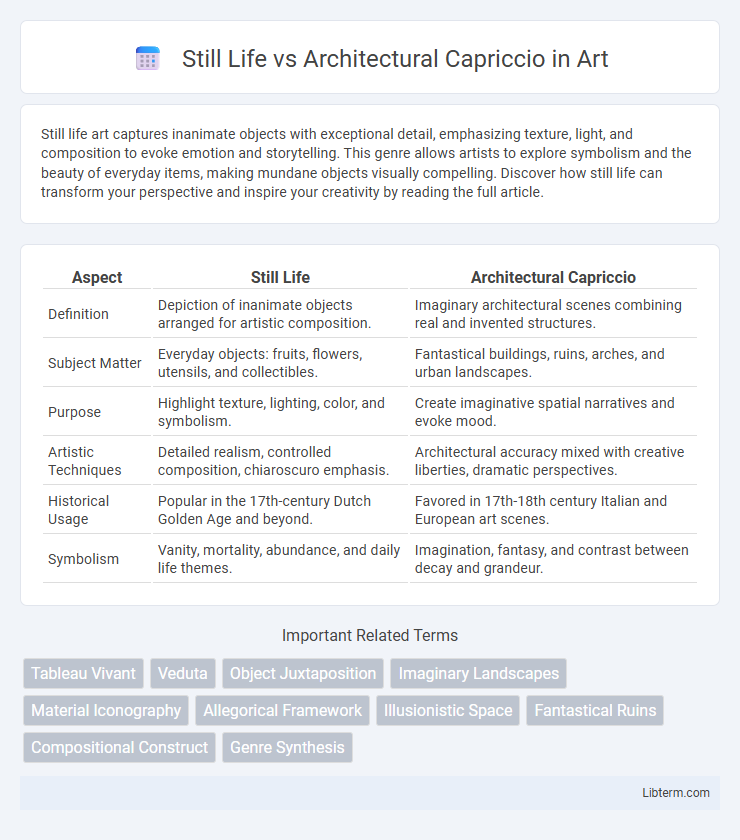Still life art captures inanimate objects with exceptional detail, emphasizing texture, light, and composition to evoke emotion and storytelling. This genre allows artists to explore symbolism and the beauty of everyday items, making mundane objects visually compelling. Discover how still life can transform your perspective and inspire your creativity by reading the full article.
Table of Comparison
| Aspect | Still Life | Architectural Capriccio |
|---|---|---|
| Definition | Depiction of inanimate objects arranged for artistic composition. | Imaginary architectural scenes combining real and invented structures. |
| Subject Matter | Everyday objects: fruits, flowers, utensils, and collectibles. | Fantastical buildings, ruins, arches, and urban landscapes. |
| Purpose | Highlight texture, lighting, color, and symbolism. | Create imaginative spatial narratives and evoke mood. |
| Artistic Techniques | Detailed realism, controlled composition, chiaroscuro emphasis. | Architectural accuracy mixed with creative liberties, dramatic perspectives. |
| Historical Usage | Popular in the 17th-century Dutch Golden Age and beyond. | Favored in 17th-18th century Italian and European art scenes. |
| Symbolism | Vanity, mortality, abundance, and daily life themes. | Imagination, fantasy, and contrast between decay and grandeur. |
Introduction to Still Life and Architectural Capriccio
Still Life art captures inanimate objects, emphasizing texture, light, and arrangement to evoke aesthetic and symbolic meaning. Architectural Capriccio combines real and imagined architectural elements, creating fantastical cityscapes that showcase perspective and structural creativity. Both genres highlight artistic skill but differ in subject matter, with Still Life focusing on detailed object portrayal and Capriccio exploring architectural imagination.
Historical Origins and Development
Still life painting traces its origins to ancient Egyptian and Roman art, evolving significantly during the Renaissance as artists emphasized realism and symbolic content. Architectural capriccio emerged in 16th-century Italy, blending imaginative architecture with real structures to create fantastical cityscapes, reflecting Baroque artistic innovation. The development of still life prioritized detailed representation of everyday objects, while architectural capriccio invested in creative spatial compositions and atmospheric perspective.
Core Characteristics of Still Life
Still Life paintings focus on inanimate objects meticulously arranged to highlight texture, light, and composition, emphasizing realism and symbolic meaning. Core characteristics include attention to detail, rich color palettes, and the portrayal of everyday items such as fruits, flowers, and household objects. Unlike Architectural Capriccio, which blends imaginative architectural elements and landscapes, Still Life centers on tangible objects within a confined space.
Defining Features of Architectural Capriccio
Architectural Capriccio is characterized by imaginative and fantastical compositions that blend real and invented architectural elements into surreal cityscapes. These paintings often feature monumental ruins, whimsical structures, and dramatic perspectives that emphasize grandeur and creativity over realistic representation. Unlike Still Life, which focuses on ordinary objects arranged in a controlled setting, Architectural Capriccio prioritizes architectural fantasy and elaborate spatial depth to evoke awe and narrative intrigue.
Symbolism and Meaning in Still Life
Still Life paintings often employ everyday objects as symbolic elements representing themes such as mortality, transience, and the passage of time, conveying deeper reflections on human existence. The careful arrangement of items like wilting flowers, extinguished candles, or hourglasses serves as memento mori, reminding viewers of life's impermanence. In contrast, Architectural Capriccio uses imaginative architectural elements to explore fantastical or historic themes, emphasizing creativity over symbolic meaning found in Still Life compositions.
Imagination and Fantasy in Capriccio Art
Architectural Capriccio art thrives on imaginative compositions that blend real and fantastical architectural elements, creating surreal landscapes impossible in reality. Unlike Still Life, which emphasizes tangible, everyday objects with precise detail, Capriccio showcases the artist's creative fantasy by reinterpreting classical ruins and architectural features. This imaginative freedom invites viewers to explore dreamlike, invented spaces that blur historical accuracy with artistic invention.
Techniques and Composition Contrasts
Still Life paintings emphasize meticulous arrangement and texture rendering through techniques like chiaroscuro and glazing to create depth and realism within a confined space. Architectural Capriccio combines imaginative architectural elements with perspective distortion, utilizing linear perspective and dramatic lighting to evoke fantasy and spatial expansiveness. The composition in Still Life is tightly controlled and intimate, while Architectural Capriccio often embraces complex, grandiose layouts with surreal juxtapositions, highlighting contrasting approaches to spatial organization.
Influential Artists in Both Genres
Influential artists in Still Life include Caravaggio and Paul Cezanne, who elevated everyday objects through dramatic lighting and innovative composition, creating a profound impact on the genre's realism and abstraction. Architectural Capriccio features masters like Giovanni Battista Piranesi and Canaletto, known for their imaginative fantasies and detailed urban landscapes that blend real and fantastical architectural elements. Both genres showcase artists who manipulate perception and space, with Still Life focusing on tangible objects and Architectural Capriccio emphasizing architectural invention.
Cultural Impact and Evolution Over Time
Still Life paintings emphasize the cultural significance of everyday objects, reflecting societal values and material culture, while Architectural Capriccio captures imaginative and fantastical architectural landscapes, influencing perceptions of urban and historical spaces. Over time, Still Life evolved from symbolic and religious representations in the Renaissance to more diverse and experimental forms in contemporary art, highlighting consumerism and mortality. Architectural Capriccio transitioned from Baroque dramatization of ancient ruins to modern artistic expressions that blend reality with fantasy, shaping the cultural dialogue around heritage preservation and urban identity.
Contemporary Reinterpretations and Relevance
Contemporary reinterpretations of still life and architectural capriccio emphasize innovative perspectives that blend traditional techniques with modern aesthetics, enhancing their relevance in today's art scene. Artists integrate digital media and abstract elements in still life compositions to explore everyday objects' symbolic meanings, while architectural capriccio often incorporates futuristic cityscapes and imaginative structures, reflecting contemporary urban experiences. This fusion of historic styles with current themes revitalizes both genres, attracting new audiences and expanding their cultural significance in modern visual discourse.
Still Life Infographic

 libterm.com
libterm.com